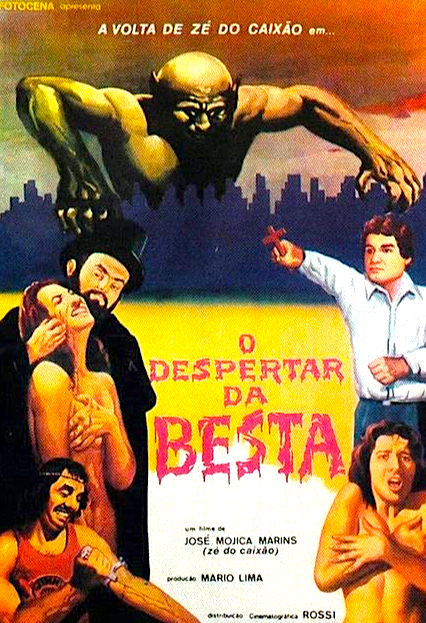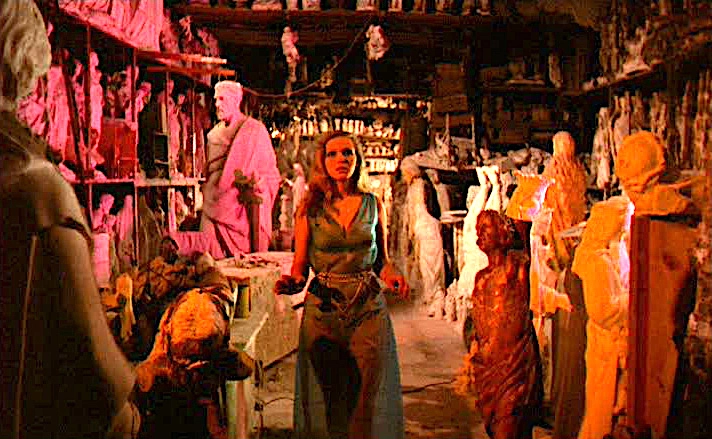HOME | REVIEWS: A-Z | FURTHER READING | NEWS | ABOUT
Awakening of the Beast
1969 / Black & White and Colour / 93 m. / Brazil / O ritual dos sadicos, O despertar da besta
Starring: Jose Mojica Marins, Sergio Hingst, Ozualdo Candeias, Andreia Bryan, Lurdes Ribas, Mario Lima, Roney Wanderney, Helena Nogueira, Graveto, Jose Carlos
Cinematography: Giorgio Attili
Production Designer: Nico Rosso
Film Editor: Luis Elias
Written by: Jose Mojica Marins and Rubens F. Lucchetti
Produced by: Giorgio Attili, Jose Mojica Marins and George Michel Serkeis
Directed by: Jose Mojica Marins
Reviewed by Lee Broughton
Synopsis:
The reasons for the perceived moral collapse of modern Brazilian society are being debated on the TV show A Light in the Darkness. A psychiatrist called Dr. Sergio presents a series of dramatic vignettes, which serve to highlight the perils of narcotics abuse and illicit sexual activity. The doctor’s fellow intellectual panelists question why the popular filmmaker Jose Mojica Marins has been invited to take part in the debate before probing Dr. Sergio about the rumours which suggest that the doctor is an unethical operator.
Dr. Sergio admits that he administered LSD to four willing human subjects and he goes on to reveal the fuller details of his experiment: the four test subjects were asked to focus on a poster depicting Marins’ evil filmic alter ego Zé do Caixão (AKA Coffin Joe) and their subsequent LSD-induced hallucinations transported each of them to a psychedelic Hell-world where they were tormented by a malevolent supernatural entity, the misogynistic and sadistic Coffin Joe in person.
Critique:
The bizarre, brutal and disturbing content of Jose Mojica Marins’ first two Coffin Joe movies (At Midnight I Will Take Your Soul [À Meia Noite Levarei Sua Alma, 1964] and This Night I Will Possess Your Corpse [Esta Noite Encarnarei no Teu Cadáver, 1967])- along with the films’ wilfully mean-spirited and firmly anti-establishment stances – served to transform the filmmaker into something of a cause celebre and a major media star in Brazil during the 1960s.
However, his distinctive media profile also brought his work to the attention of the reactionary Brazilian authorities. Presumably in an attempt to sidestep Brazil’s increasingly oppressive state censor, Marins cooked up Awakening of the Beast, which is essentially a Brechtian and metatextual docudrama-cum-mocumentary that serves to separate the filmmaker from his sadistic filmic alter ego while still perpetuating and promoting the Coffin Joe mythos.
Unfortunately for Marins, neither the distancing effect of his really quite clever docudrama/mocumentary approach or his vague criticisms of media effects theory could fully disguise the film’s still apparently subversive symbolic content, which resulted in Awakening of the Beast being banned outright in Brazil for over twenty years.
The show opens with a scene that features Coffin Joe himself. Sporting his sinister black top hat, cloak and mysterious mystical medallion, Joe pointedly reflects back the criticisms levelled at both him and Marins by breaking the fourth wall and directly addressing the audience with the words, “My world is strange … Though it may be filled with strange people, none … are stranger THAN YOU!”
Coffin Joe’s schlock horror approach here brings to mind elements of the mock horror stage personas adopted by Screamin’ Jay Hawkins and his UK counterpart Screaming Lord Sutch. The film’s credits then play over shots of panels from Coffin Joe comics before the action cuts to the dramatic vignettes that Dr. Sergio is relating to his fellow TV show panelists. One panelist describes the doctor’s case-studies as being “a catalogue of depravity.”
Depraved or not, the vignettes themselves are a bit of a mixed bag in cinematic terms. Some of them are staged in a fairly conventional way, coming on like simple dramatic reconstructions of the doctor’s file papers. Others are set to music and play like they have been staged and performed by a beatnik performance art collective. The choreography that marries the visuals to the soundtrack in these performance art-like vignettes works very well for the most part and some interesting songs are featured too.
Many of the vignettes include bizarre aspects that are of a very surreal and avant garde nature. A sequence where an unsavoury businessman is eating pasta winds up bringing to mind Auntie Jessie’s (Jessie Robins) nightmare about eating spaghetti from The Beatles’ Magical Mystery Tour (1967) film. Nearly all of the vignettes feature sleazy or disturbing scenarios and a range of female characters who are invariably presented in various stages of undress.
Consequently, there’s a bit of a sub-exploitation/sexploitation cinema-like vibe apparent here at times that clashes head on with the art film-cum-world cinema-like ambience that is also very much present. Evidence of budgetary constraints, and the use of the odd (intentionally?) incongruous music cue, briefly gives a couple of the sequences featured here the air of an Ed Wood Jr. or Doris Wishman film.
The scenes set on the A Light in the Darkness TV programme are staged in a convincing round-table-debate-cum-current affairs TV show-like manner, with realistic behind-the-scenes activity in the TV studio being revealed at one point. It’s here that Jose Mojica Marins gets to offer a representation of his real world self. He tells the panel “My position is neutral. I don’t even know why I’m here” before going on to warn the snobbish intellectuals that they should not confuse him with his Coffin Joe alter ego.
Indeed, Marins is keen to stress that Coffin Joe is merely a fictional character that he chooses to play. Dr. Sergio explains that he saw Marins on another TV show, The People’s Court of Truth, which allows the doctor to reminisce about that show’s content: with his reminiscences presented on a television screen, we see Marins being questioned and judged by a panel of regular Brazilian citizens, who wind up validating his opinions and acknowledging his integrity and talent.
This is a neat filmic device that effectively allows Marins to provide evidence of the plaudits that his work has received and to articulate his forthright views on the state of filmmaking in Brazil – and a variety of other topics – directly to his current film’s audience. A sequence which details the doctor setting up his LSD-based experiment features encounters with more Coffin Joe comics, a Coffin Joe poster, a Coffin Joe pop song and a visit to a cinema that is screening This Night I Will Possess Your Corpse. Clips from the earlier film are effectively utilised onscreen for a spell.
All of the action up to now has been presented in black and white but when Dr. Sergio’s test subjects have their doses of LSD administered, their subsequent hallucinations are brought to life via some very lively and really quite startling colour cinematography. Some ultra-psychedelic colour schemes and solarization effects are employed in this section of the film. Coffin Joe’s nightmarish world is convincing and it is inhabited by all manner of strange creatures. And these strange creatures are brought to life in some very inventive and effective ways.
The lengthy and surreal hallucinogenic sequences, like some of Dr. Sergio’s earlier dramatic vignettes, feature a whole range of disorientating and freak-out inducing camera angles as well as a number of whacked out and trippy editing techniques. The soundtrack for these sequences is an avant-garde cacophony that is very unsettling and disturbing. Treated cackles, screams, moans and cries, strange choral arrangements and electronic effects fed through audio generators, reverb units and echo boxes all vie for aural supremacy. It’s all very impressive and effective stuff.
The doctor duly reveals that – in spite of their truly horrifying and mind-bending experiences – his test subjects survived their ordeal unscathed and he imparts one final revelation that is intended to counter the accusations of unethical working methods that have been levelled at him while simultaneously corroborating his theses concerning the reasons why Brazilian society is perceived to be in a state of moral decline.
Awakening of the Beast’s content suggests that Marins was an extremely media-savvy operator. The show is distinctly post-modern in the way that it draws upon a number of filmic textual devices and styles, along with a variety of musical and print-based texts, and jumbles them all into a sub-psychedelic and surreal but highly effective exercise in self-promotion. And his ability to expertly mix the tenets and tones of both popular trash and impenetrable art movies results in a film that will undoubtedly appeal to lovers of outré and subversive cinema.
Psychotronic Cinemas rating: Good ++ (Freak Out Factor: Excellent)
© Copyright 2007, 2022 Lee Broughton.
HOME | REVIEWS: A-Z | FURTHER READING | NEWS | ABOUT





You must be logged in to post a comment.